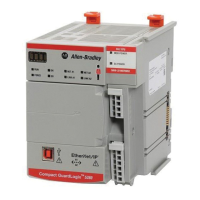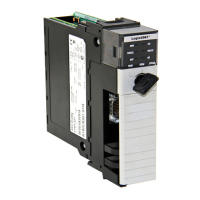376 Rockwell Automation Publication MOTION-RM003I-EN-P - February 2018
Scaling mode the drive is responsible for Position Unwind (Cyclic Unwind)
operations associated with Cyclic Travel Mode (Cyclic Unwind Control).
Scaling Source
Usage Access Data Type Default Min Max Semantics of Values
Required - All Set/ SSV# USINT 0 - - Enumeration:
0 = From Calculator
1 = Direct Scaling Factor Entry
2-255 = reserved
# Indicates the attribute cannot be set while the tracking command (Tracking Command bit in CIP Axis Status is true).
Enumerated attribute used to determine whether the scaling factors are going to
be entered directly from the user or calculated based on Position Scaling, Position
Unwind, and Travel Range values. When entered directly, the scaling factors, for
example, Conversion Constant, Position Unwind, and Motion Resolution are
expressed in units of "counts". When using the scaling calculator, the scaling
factors are calculated based on values entered by the user in the preferred units of
the application without requiring any knowledge of "counts".
Important:
Configuration of Scaling page parameters is required for any attributes expressed in position,
velocity, or acceleration units to return meaningful values.
Scaling Calculations are performed by Logix Designer application whenever the
Scaling attribute values change. Scaling attributes are defined as Position Scaling
Numerator, Position Scaling Denominator, Position Unwind Numerator,
Position Unwind Denominator, Travel Mode, and Travel Range. The purpose of
the Scaling Calculation is to generate the key Scaling Factors used to convert
between the user defined Position Units and the quantized Motion Count units
used by the control system. The set of Scaling Factor attributes consist of Motion
Resolution, Conversion Constant, and Position Unwind.
The specific Scaling Calculations performed by the Logix Designer application
depend on the Travel Mode setting as follows:
Cyclical Travel:
• Max Resolution = Int((2^31-1) * (Pos Scaling Num/Pos Scaling Denom) /
(Unwind Num/Unwind Denom))
• Base Resolution = Minimum (Default Motion Resolution, Max
Resolution)
• Motion Resolution = (Pos Scaling Num*Unwind Denom) * (10^(Int
(Log10(Base Resolution/(Pos Scaling Num*Unwind Denom)))))
• Conversion Constant = Motion Resolution * (Pos Scaling Denom/Pos
Scaling Num)

